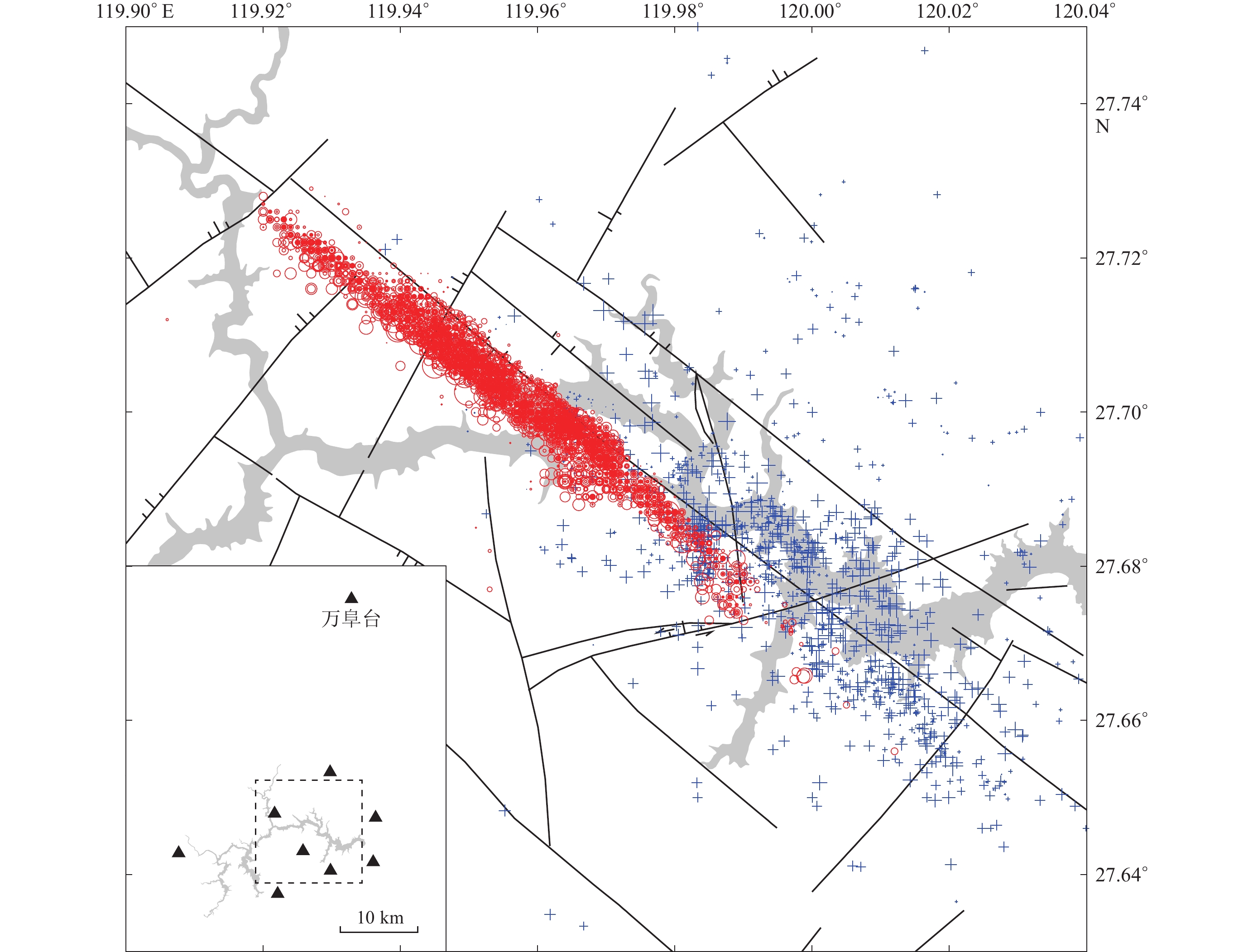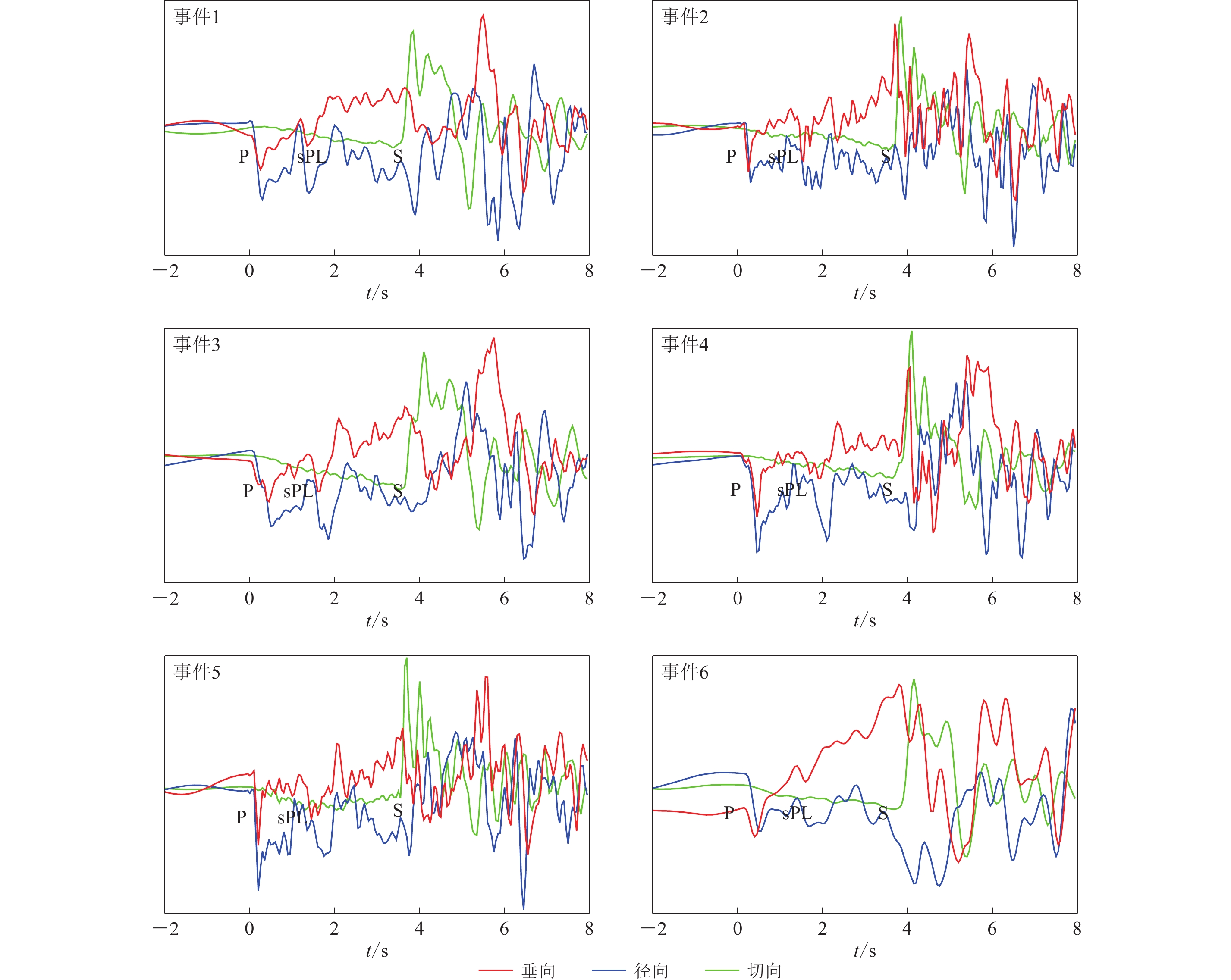Focal depth determination of Shanxi reservoir earthquakes from sPL phase with single station
-
摘要: 稀疏台网下的传统走时定位难以确定中小地震的震源深度,而地震波深度震相蕴含着震源深度信息,为确定地震震源深度提供了新的途径。近震深度震相sPL和直达Pg波到时差与震源深度呈线性关系,可用以约束地震震源深度。本文以珊溪水库2014年震群事件为例,利用单台sPL震相测定了地震震源深度。结果表明:震源深度的测定结果与基于水库台网高密度台站下Pg和Sg走时定位Hyposat方法和全波形拟合CAP方法测定的震源深度高度一致,为4—6 km,与区域活动断层探测结果相符。sPL震相的优势震中距为30—50 km,区域台网范围内sPL与Pg的到时差与震源深度的线性关系相对固定,因此利用单台sPL震相即可快速获取可靠的地震震源深度,适用于稀疏台网下的中小地震震源深度的确定,且误差可控制在1—2 km范围内。Abstract: It is difficult to determine focal depth via phase onset time fitting method for the regions where only sparse seismic stations are available. we demonstrate that focal depth can be well constrained with depth phase sPL which is sensitive to focal depth but insensitive to epicentral distance. With 2014 Shanxi reservoir earthquake swarm as a case study, this paper determined the focal depths of earthquakes by sPL phase with single station. The result show that the focal depths derived from sPL phase are well consistent with the results from CAP method and Hyposat method. The depths of the main shock and six ML>3.0 events are predominantly around 4−6 km, which is coincident with results of surveying and prospecting of active fault. Therefore sPL phase can be applied to small earthquakes for sparse network as it is well observed with small epicentral distances. Robust result of focal depth can be rapidly obtained by single broadband seismic station with bias of about 1−2 km.
-
Keywords:
- Shanxi reservoir /
- focal depth /
- depth phase /
- sPL phase
-
-
图 1 珊溪水库区域断裂、地震和台站分布图
灰色填充区为珊溪水库,三角形为台站,圆圈代表2014年震群,加号为2014年之前地震,黑线为断层
Figure 1. Fault structure and distribution of earthquakes and stations in Shanxi reservoir region
Gray region indicates Shanxi reservoir,and its surrounding fault system is depicted by line segments,open circles denote the swarm epicenters of the year 2014 while plus signs denote the swarm before the year 2014,seismic stations are indicated by triangles
图 2 sPL射线路径示意图(a)和万阜台记录的三分向位移波形(b)
图(a)中黑色为sPL及其参考震相Pg,灰色射线示意相对sPL震相其它深度震相则需更远的震中距才发育
Figure 2. Schematic illustration of sPL ray path (a) and three-component displacement waveforms recorded at Wanfu station to view sPL phase (b)
Black ray for sPL-Pg pair and gray for other depth phases which appear in farther epicentral distance in Fig.(a)
图 3 基于sPL和CAP方法确定2014年珊溪水库震群主震震源深度
(a) sPL震相敏感性测试,灰色波形表示不同深度三分向理论波形,红色波形表示万阜台显示的主震最佳拟合深度;(b) CAP反演所得的主震最优震源机制(左)和震源深度(右)
Figure 3. Focal depth determined by sPL and CAP method for the mainshock of the Shanxi reservoir swarm in 2014
(a) sPL phase depth sensitivity test,where gray waveforms represent three-component synthetics at different focal depths and red ones represent data recorded by Wanfu staion at best fitting;(b) Focal mechanism (left) and depth (right) determined by CAP method
图 4 表1中万阜台水库震群事件1—6的位移波形图
Figure 4. Displacement records of six events labeled with one to six in Table 1 at Wanfu station with vertical (red),radial (blue) and tangential (green) components
表 1 珊溪水库震群七次地震事件震源深度的测定结果
Table 1 Focal depths of seven events from Shanxi reservoir seismic swarm
序号 发震时刻 震中位置 ML 震源深度/km 年−月−日 时:分:秒 东经 北纬 sPL结果 台网结果* CAP结果 0 2014−10−14 04:14:57 119.94 27.71 4.2 5 4 4 1 2014−09−17 20:47:31 119.95 27.71 3.5 4—5 4 4 2 2014−09−23 17:40:25 119.94 27.71 3.7 4—5 4 4 3 2014−10−15 15:49:27 119.95 27.71 4.0 5—6 5 5 4 2014−10−15 16:37:24 119.96 27.70 4.0 6 5 5 5 2014−10−23 08:35:02 119.93 27.72 3.7 5 4 4 6 2014−10−26 07:03:41 119.97 27.69 3.4 4 4 / *引自浙江省数字地震台网中心地震目录(内部资料). -
崇加军,倪四道,曾祥方. 2010. sPL,一个近距离确定震源深度的震相[J]. 地球物理学报,53(11):2620–2630. Chong J J,Ni S D,Zeng X F. 2010. sPL,an effective seismic phase for determining focal depth at near distance[J]. Chinese Journal of Geophysics,53(11):2620–2630 (in Chinese).
侯林锋,晏云翔,杨福平,余刚群,李林元. 2018. 珊溪水库地区深部构造探测研究[J]. 大地测量与地球动力学,38(8):818–822. Hou L F,Yan Y X,Yang F P,Yu G Q,Li L Y. 2018. Research on deep crustal structure in Shanxi reservoir area[J]. Journal of Geodesy and Geodynamics,38(8):818–822 (in Chinese).
罗艳,曾祥方,倪四道. 2013. 震源深度测定方法研究进展[J]. 地球物理学进展,28(5):2309–2321. doi: 10.6038/pg20130513 Luo Y,Zeng X F,Ni S D. 2013. Progress on the determination of focal depth[J]. Progress in Geophysics,28(5):2309–2321 (in Chinese).
马起杨,朱新运. 2016. 浙江珊溪水库地震震源参数特征研究[J]. 地震学报,38(6):835–846. doi: 10.11939/jass.2016.06.003 Ma Q Y,Zhu X Y. 2016. Characteristics of source parameters of the Shanxi reservoir earthquakes in Zhejiang region[J]. Acta Seismologica Sinica,38(6):835–846 (in Chinese).
马志江,钟羽云,韩用兵,叶建青,张震峰,林胜法,徐梦林,刘倩倩. 2016. 温州珊溪水库诱发地震构造条件[J]. 地球科学,41(8):1413–1423. Ma Z J,Zhong Y Y,Han Y B,Ye J Q,Zhang Z F,Lin S F,Xu M L,Liu Q Q. 2016. The tectonic conditions of Shanxi reservoir induced earthquake in Wenzhou[J]. Earth Science,41(8):1413–1423 (in Chinese).
于俊谊,马起杨. 2017. 珊溪水库地区b值时空变化特征分析[J]. 山西地震,(3):1–5. doi: 10.3969/j.issn.1000-6265.2017.03.001 Yu J Y,Ma Q Y. 2017. Analysis of the spatio-temporal variation characteristic of b-value in Shanxi reservoir area[J]. Earthquake Research in Shanxi,(3):1–5 (in Chinese).
张瑞青,吴庆举. 2008. 四川攀枝花2008年8月31日MS5.6地震震源深度的确定[J]. 国际地震动态,(12):1–5. doi: 10.3969/j.issn.0253-4975.2008.12.001 Zhang R Q,Wu Q J. 2008. Focal depth for an earthquake (MS5.6) on August 31,2008 in Panzhihua of Sichuan Province[J]. Recent Developments in World Seismology,(12):1–5 (in Chinese).
赵冬,韩用兵,叶建青. 2006. 2006年2月浙江泰顺—文成地震震群震害特征[J]. 震灾防御技术,1(2):169–171. doi: 10.3969/j.issn.1673-5722.2006.02.011 Zhao D,Han Y B,Ye J Q. 2006. The damage features of the group earthquakes occurred in February 2006,in Taishun-Wencheng,Zhejiang Province[J]. Technology for Earthquake Disaster Prevention,1(2):169–171 (in Chinese).
钟羽云,张帆,阚宝祥. 2015. 基于Gassmann方程的流体替换方法在珊溪水库地震研究中的应用[J]. 地震工程学报,37(3):678–686. doi: 10.3969/j.issn.1000-0844.2015.03.0678 Zhong Y Y,Zhang F,Kan B X. 2015. Application of Gassmann equation based fluid substitution method to the research of reservoir-induced earthquakes at Shanxi reservoir[J]. China Earthquake Engineering Journal,37(3):678–686 (in Chinese).
周昕,钟羽云,傅建武,杨福平,张帆. 2006. 珊溪水库地震与构造地震波谱时−频特征的对比研究[J]. 大地测量与地球动力学,26(4):86–91. Zhou X,Zhong Y Y,Fu J W,Yang F P,Zhang F. 2006. Contrast of time-frequency characteristics of wave spectrum between Shanxi reservoir induced earthquake and tectonic earthquake[J]. Journal of Geodesy and Geodynamics,26(4):86–91 (in Chinese).
朱新运,张帆,于俊谊. 2010. 浙江珊溪水库地震精细定位及构造研究[J]. 中国地震,26(4):380–390. doi: 10.3969/j.issn.1001-4683.2010.04.003 Zhu X Y,Zhang F,Yu J Y. 2010. Study on precise positioning and structure of the Shanxi reservoir earthquake,Zhejiang Province[J]. Earthquake Research in China,26(4):380–390 (in Chinese).
Laske G, Masters G, Ma Z T, Pasyanos M. 2013. Update on CRUST1.0: A 1-degree global model of earth’s crust[C]//Proceedings of EGU General Assembly Conference. Vienna: EGU.
Saikia C K,Woods B B,Thio H K. 2001. Calibration of the regional crustal waveguide and the retrieval of source parameters using waveform modeling[J]. Pure Appl Geophys,158(7):1301–1338.
Scholz C H. 2002. The Mechanics of Earthquakes and Faulting[M]. Cambridge: Cambridge University Press: 496.
Wang Z J,Chong J J,Ni S D,Romanowicz B. 2011. Determination of focal depth by two waveform-based methods:A case study for the 2008 Panzhihua earthquake[J]. Earthquake Science,24(4):321–328.
Zhao L S,Helmberger D V. 1994. Source estimation from broadband regional seismograms[J]. Bull Seismol Soc Am,84(1):91–104.
Zhu L P,Helmberger D V. 1996. Advancement in source estimation techniques using broadband regional seismograms[J]. Bull Seismol Soc Am,86(5):1634–1641.
Zhu L P,Rivera L A. 2002. A note on the dynamic and static displacements from a point source in multi layered media[J]. Geophys J Int,148(3):619–627. doi: 10.1046/j.1365-246X.2002.01610.x





 下载:
下载:



